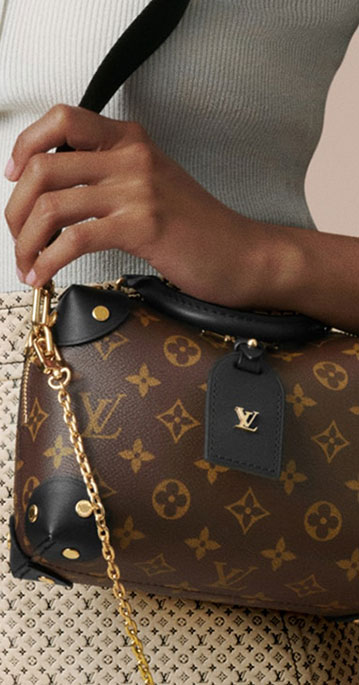Chapter 1
The fashion and luxury retail industry includes a literal wealth of products. For the purposes of clarity in this guide, we’ll often use the term “luxury goods,” when referring to the industry as a whole. Luxury goods can be separated into two primary categories: hard luxury and soft luxury.
Hard luxury goods include items like watches and jewelry. For decades, most consumers purchased hard luxury goods from storefronts where they could physically handle these products. Brands in this section of the industry include:


Soft luxury goods include leather accessories, bags, glasses, and designer clothing and shoes. These products include brands such as:
Fashion brands in this category also include brands like Gap, Ann Taylor, Zara, and other mid-level retail brands.
Like any story about revenue and projections, the fashion and luxury goods industry story is a tale of two timeframes: before and after March 2020.
Before the pandemic, the industry was growing steadily. In 2008, it accounted for $188 billion and reached $307 billion in 2018. In 2019, online luxury fashion retail platform, Farfetch projected that the market would reach $430 billion by 2025. Deloitte's 2019 report, “Global Powers of Luxury Goods” rated the market positively, with some caution related to Brexit and an economic slowdown in U.S., Europe, and China. Still, the industry was valued at $247 billion worldwide with a 10.8% composite year-over-year sales growth and composite net profit margin of 9.8%.
The Luxury Institute’s “State of the Luxury Industry 2020” reflected the same optimism in January 2020, reporting positive signs of growth and indicating that fashion and luxury goods accounted for the lion’s share of consumer spending.
That optimism turned out to be a bit misplaced.

As the pandemic spread, the fashion and luxury goods industry was significantly impacted, taking a 23% hit in 2020 and contracting for only the second time since 2009, according to Bain & Company.
This decline happened for a number of reasons, all related to the COVID-19 pandemic.
While many retailers were able to quickly shift their stores online, global luxury brands had to battle consumer behavior that favored in-store shopping. In the same Luxury Institute 2020 report, over 60% of affluent consumers indicated they would rather purchase in stores, and that preference was even more pronounced in top industry markets like South Korea (82%), France (71%), and China (70%).
“Part of the appeal of luxury goods shopping in person is that it is so immersive,” says Sarah Elizabeth, Senior Director, Growth Strategy with ClearSale. “Everything from the lighting to the music to the scent of the store is meticulously planned to create a luxurious, indelible experience that feels like a treat in its own right. Businesses had little time to create an online presence with that same luxurious feel, resulting in some significant shifts in market share.”
Another contributor to the industry’s decline was travel-related. About 40% of fashion and luxury goods purchases had been attributed to shopping in airports and duty-free stores, on cruise ships, and at vacation destinations. When global travel stopped entirely, it took a big bite out of industry revenue.
But the biggest cause of the decline had to do with geography. The two top markets for fashion and luxury goods – China and Italy – were the first to feel the impact of COVID-19. The complete shutdowns in both countries kept consumers out of stores altogether.
![[Wide 1200x630] Ecommerce Fraud Risk_ China](https://offer.clear.sale/hubfs/%5BWide%201200x630%5D%20Ecommerce%20Fraud%20Risk_%20China.webp)
When we look at fashion and luxury goods industry segments, sales declined across the board. For some, the decline was less pronounced — for example, the accessories segment was least affected and represented 36% of the total sales. Still, each segment suffered significantly:
![[Wide 1200x630] The Impact of COVID-19 on the Ecommerce Industry](https://offer.clear.sale/hubfs/%5BWide%201200x630%5D%20The%20Impact%20of%20COVID-19%20on%20the%20Ecommerce%20Industry.png)
For more information about “The Impact of COVID-19 on the Ecommerce Industry”.
READ NOWDespite this decline, hope is on the horizon: Global luxury brands appear to be recovering, with McKinsey forecasting a value of €426B by 2025.
As ClearSale data analyst Eduardo Gerolamo explained, "After a long period where joy was in short supply, consumers will likely be feeling celebratory…and eager to go shopping.”
In China, which accounted for nearly 90% of industry growth before 2020, consumers were primed and ready to shop when lockdowns were lifted. They flocked to luxury boutiques and helped breathe life back into the industry.
In other markets like the U.S., “retail therapy” to combat the psychological toll of lockdowns and isolation created a whole new segment of luxury consumers who felt the need to splurge and treat themselves.
The largest industry segment, luxury fashion, has posted revenues of $108 million, mostly generated in the U.S. Within luxury fashion, luxury apparel accounts for the most global revenue at $72 million, and the U.S. is once again the biggest consumer, generating $27 million in revenue.
And what about hard luxury goods? A June 2022 Statista market outlook for luxury watches and jewelry had the segment projected at US$67.97 billion worldwide in 2022, with annual growth expectations of 4.11% (CAGR 2022-2027).